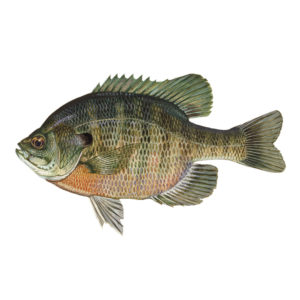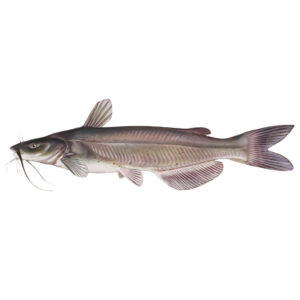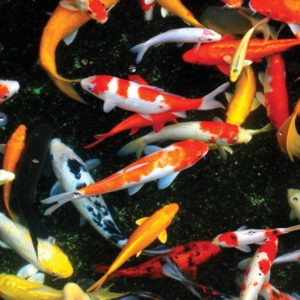Registered Aquaculture Facility
Stoney Creek Fisheries is a registered aquaculture facility with the Michigan Department of Agriculture and Rural Development. All of our fish stocks are certified annually to be disease-free. We strive to continually provide the finest sport fish fingerlings in Michigan at an affordable price. Stock fish below are available usually mid to late April through October unless otherwise noted. (Fish sale start date is subject to change.)
We do recommend you call in advance for fish availability as every year is different.
Warm Water Fish
Some sizes may be unavailable at times.
| Size of Fish | 2024 Price Each | Stocking Rate Fish per Acre | Minimum Order | Prey | Predator | Max. Size (inches) | Max. Age (years) | Optimum Temp (F) | |
| Hybrid Bluegill | 2″ – 4″ | $0.95 | 300-600 | 25 |  |
12-15 | 6-8 | 70º-84º | |
| Hybrid Bluegill | 4″ – 6″ | $1.75 | 300-600 | 25 |  |
12-15 | 6-8 | 70º-84º | |
| Largemouth Bass | 3″ – 4″ | $2.00 | 50-100 | 25 |  |
20-25 | 10-11 | 68º-82º | |
| Largemouth Bass | 4″ – 6″ | $3.10 | 50-100 | 25 |  |
20-25 | 10-11 | 68º-82º | |
| Largemouth Bass | 6″ – 8″ | $5.00 | 50-100 | 25 |  |
20-25 | 10-11 | 68º-82º | |
| Channel Catfish | 4″ – 6″ | $1.00 | 50-100 | 25 |  |
32-38 | 20+ | 72º-84º | |
| Channel Catfish | 6″ – 8″ | $1.25 | 50-100 | 25 |  |
32-38 | 20+ | 72º-84º | |
| Black Crappie* | 3″ – 4″ | $1.70 | 100-200 | 100 |  |
 |
13-16 | 7-10 | 65º-80º |
| Black Crappie* | 4″ – 6″ | $2.50 | 100-200 | 100 |  |
 |
13-16 | 7-10 | 65º-80º |
*Advance orders and down payment required by mid September **Crappie price may change based on available size in October.
Cool Water Fish
Some sizes may be unavailable at times.
| Size of Fish | 2024 Price Each | Stocking Rate Fish per Acre | Minimum Order | Prey | Predator | Max. Size (inches) | Max. Age (years) | Optimum Temp (F) | |
| Yellow Perch | 4″ – 5″ | $2.25 | 200-300 | 25 |  |
 |
12-15 | 9-10 | 67º-76º |
| Yellow Perch | 5″ – 7″ | $3.00 | 200-300 | 25 |  |
 |
12-15 | 9-10 | 67º-76º |
| Walleye* | 5″ – 8″ | $4.00 | 25-50 | 100 |  |
24-28 | 10-12 | 65º-75º | |
*Advance orders and down payment required by mid September. **Walleye sizes may vary. Price may change based on those available sizes in October.
Cold Water Fish
Some sizes may be unavailable at times.
| Size of Fish | 2024 Price Each | Stocking Rate Fish per Acre | Minimum Order | Prey | Predator | Max. Size (inches) | Max. Age (years) | Optimum Temp (F) | |
| Rainbow Trout | 4″ – 6″ | $2.25 | 50-100 | 25 |  |
20-30 | 9-11 | 55º-65º | |
| Rainbow Trout | 8″ – 10″ | $4.00 | 50-100 | 25 |  |
20-30 | 9-11 | 55º-65º |
Ornamental Fish
| Size of Fish | 2024 Price Each | |
| Koi | 3″ – 12″ | $25+ |
| Assorted Goldfish | 2″ – 6″ | $4.00+ |
Forage/Feeder Fish
| Size | 2024 Price Each | |
| Fathead Minnows | 1/2 Gallon | $44.00 |
| 1-4 Gallon | $72.00 | |
| 5-9 Gallons | $70.00 | |
| 10-19 Gallons | $68.00 | |
| 20+ Gallons | $66.00 |
Available Apr. – Oct.
Fish Stocking Examples
Whether stocking a new pond or adding fish to the present population there are several factors to consider. Pond dynamics such as size, depth temperatures, weed coverage, structure and clarity all help determine what species and how many fish to stock.
Because every pond is different, we do not sell fish “packages.” Working with some rules of thumb we have some examples of what maximum fish stocking rates could look like. These maximum stocking rate examples do assume a few things.
- The stocking rate examples assume the pond is properly aerated. Without aeration your pond can not sustain as many fish.
- An average of approximately 1000 fish per acre is used. Again, this assumes proper aeration. Have we mentioned yet how important aeration is to a successful fish population?
- These rates also assume a ratio of approximately 6:1 of non-predator fish to predator fish.
- Sizes of fish can be changed from the below examples.
Small Ponds, 8' - 10' depth
1/4 Acre EXAMPLE
| 200 | 2″ – 4″ hybrid bluegill |
| 60 | 4″ – 5″ yellow perch |
| 15 | 4″ – 6″ channel catfish |
| 25 | 4″ – 6″ largemouth bass |
| 1 | gallon of minnows |
Estimated cost of this EXAMPLE $489.50
Tax and other fees would be additional
Medium Ponds, 10' - 12' depth
1/2 Acre EXAMPLE
| 300 | 2″ – 4″ hybrid bluegill |
| 125 | 4″ – 5″ yellow perch |
| 25 | 4″ – 6″ channel catfish |
| 50 | 4″ – 6″ largemouth bass |
| 2 | gallons of minnows |
Estimated cost of this EXAMPLE $890.25
Tax and other fees would be additional
Large Deep Ponds, over 14' deep
1 Acre+ EXAMPLE
| 650 | 2″ – 4″ hybrid bluegill |
| 200 | 4″ – 5″ yellow perch |
| 75 | 4″ – 6″ channel catfish |
| 75 | 4″ – 6″ largemouth bass |
| 3 | gallons of minnows |
Estimated cost of this EXAMPLE $1,453.50
Tax and other fees would be additional
Please contact us and we’ll be happy to help you with your fish stocking needs.
We strongly recommend you call in advance for fish availability.
DELIVERY CHARGE: $100 – $250 • $1000 MINIMUM Fish Order for Delivery (Excludes Minnows)
Delivery is based on distance from Stoney Creek. Four to six orders are required for a full truck to deliver into your general area. Delivery fees range from $100 to $250+ (depending on location) within 150 miles of Stoney Creek Fisheries. Delivery distances greater than 150 miles will require a quote.
These fish are available to our Michigan customers. We do not air ship fish.
Stoney Creek does NOT recommend fish pick-ups during hot weather (late June through early September).
The total combined stress to the fish from handling, bagging, transport time, and lengthy tempering is often too high.
As an additional bio-security measure, Stoney Creek ensures all fish stocks are sampled for health certification annually.
10% DISCOUNT ON ALL FISH PURCHASES OVER $1000.00*
*Excluding feed minnows, equipment and delivery fee.
All fish prices subject to change
REMEMBER: When stocking a fish pond or lake for the first time or when adding fish to the present population, factors such as size of pond, depth, temperatures, weeds present or not present, structure, clarity, etc., all determine what kind and how many fish to stock. Please give us a call or stop in and see us for more information.
Warm Water Fish
Cool and Cold Water Fish
Ornamental Fish
Feeder Fish
Game fish illustrations courtesy of U.S. Fish & Wildlife Service.








 Assorted Goldfish, like koi, are bright and colorful and often used in water gardens by themselves or mixed with koi. Common goldfish, Comets, Sarassas, Shubunkins and Fantails are some of the many varieties. They will readily consume commercial feed pellets as well as grazing on algae and other plants; they thrive in ponds with ample weed cover and will freely spawn in most ponds.
Assorted Goldfish, like koi, are bright and colorful and often used in water gardens by themselves or mixed with koi. Common goldfish, Comets, Sarassas, Shubunkins and Fantails are some of the many varieties. They will readily consume commercial feed pellets as well as grazing on algae and other plants; they thrive in ponds with ample weed cover and will freely spawn in most ponds. Koi are bright, decorative fish commonly found in parks, zoos and ornamental ponds because of their high visibility. Koi are helpful in controlling algae, duckweed, elodea and other weeds. Do not confuse with the weed eating fish called grass carp, which are illegal to stock in Michigan. Koi can reach lengths of 24″ and can reproduce in ponds. Most offspring from Koi are usually eaten by other fish and birds because of their bright colors. You should quarantine new Koi when adding to your present population. Sizing depends on availability.
Koi are bright, decorative fish commonly found in parks, zoos and ornamental ponds because of their high visibility. Koi are helpful in controlling algae, duckweed, elodea and other weeds. Do not confuse with the weed eating fish called grass carp, which are illegal to stock in Michigan. Koi can reach lengths of 24″ and can reproduce in ponds. Most offspring from Koi are usually eaten by other fish and birds because of their bright colors. You should quarantine new Koi when adding to your present population. Sizing depends on availability.